The USSR and the USA are two world superpowers that vied for primacy in everything from the post-war period to the early 90s of the last century. A very important aspect of this struggle was the economy. Of particular importance was the GDP of the USSR and the USA. Comparison of these indicators was a pretty powerful tool in promoting both countries. But at the same time, with the help of these economic data, we will also be able now, through the veil of the past years, to really restore the state of affairs in the countries studied. So, what was the GDP of the USSR and the USA during their rivalry?
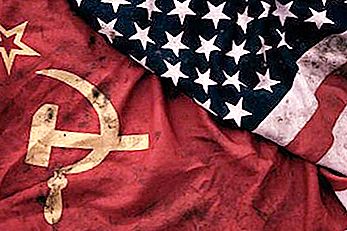
The concept of gross product
But before we analyze the GDP of the USSR and the USA, let's find out what this concept is in general and what types of it exist.
Gross domestic product (GDP) is the value of all goods and services produced in a particular state or region. If we divide the total GDP by the average population of the territory to which it belongs, then we will get the gross product per capita.
Gross domestic product indicators can be divided into two large groups: nominal and purchasing power parity. The nominal gross product is denominated in the national currency, or in terms of the currency of any other country at the established rate. When calculating GDP at purchasing power parity, the ratio of currencies to each other by purchasing power relative to a particular type of goods or services is taken into account.
Comparison of economic indicators before World War II
Although the main peak of the rivalry between the USSR and the USA falls on the period after World War II, to complete the picture it is not out of place to look at how their GDP dynamics changed in the first half of the 20th century.
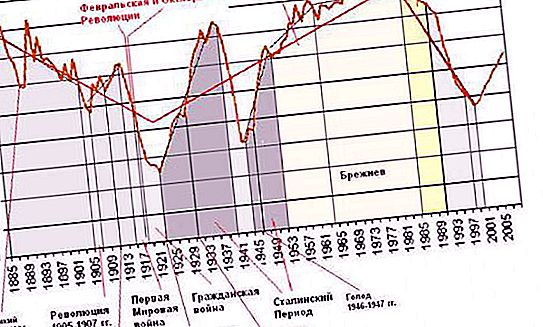
The pre-war period was rather difficult both for the USSR economy and for the US economy. In the Soviet Union at that time, the country was recovering from the Civil War, which resulted in two of the strongest famines of 1922 and 1932-1933, while the United States experienced a period of its history in 1929-1932, known as the Great Depression.
Most of all, the economy of the country of the Soviets dipped in relation to US GDP immediately after the Civil War in 1922. At that time, domestic GDP was only about 13% of that in the United States. But, in the following years, the USSR began to rapidly reduce the backlog. By the pre-war period of 1940, the USSR’s GDP was equal to $ 417 billion in terms of the American currency, which was already 44% of the United States. That is, the Americans in that period, the gross domestic product amounted to about $ 950 billion.
But the outbreak of war hit the USSR economy much harder than the American. This was due to the fact that the fighting took place directly on the territory of the Soviet Union, and the United States fought only abroad. By the end of World War II, the USSR’s GDP was only about 17% of the US gross domestic product. But, again, after the restoration of production began, the gap between the economies of the two states began to rapidly narrow.
Comparison of GDP 1950-1970
In 1950, the share of the USSR in world GDP was 9.6%. This amounted to 35% of US GDP, that is, even lower than the pre-war level, but, nevertheless, much higher than the figure for the first post-war year.
In subsequent years, the difference in the gross products of the two superpowers, which by that time the USSR and the USA had become, decreased more and more, although not at such a fast pace as before. By 1970, Soviet GDP was about 40% of the United States, which was already quite an impressive indicator.
USSR GDP after 1970
What interests us most is the state of the economy of the USSR and the USA after 1970 until the end of the existence of the Soviet Union, when the rivalry between them reached its maximum. Therefore, over this period we consider the GDP of the USSR by years. Then we will do the same with the gross domestic product of the United States. Well, in the final stage, we compare these results.
USSR GDP for 1970 - 1990 in million dollars:
- 1970 - 433, 400;
- 1971 - 455, 600;
- 1972 - 515, 800;
- 1973 - 617, 800;
- 1974 - 616, 600;
- 1975 - 686, 000;
- 1976 - 688, 500;
- 1977 - 738, 400;
- 1978 - 840, 100;
- 1979 - 901, 600;
- 1980 - 940, 000;
- 1981 - 906 900;
- 1982 - 959, 900;
- 1983 - 993, 000;
- 1984 - 938, 300;
- 1985 - 914, 100;
- 1986 - 946 900;
- 1987 - 888 300;
- 1988 - 866 900;
- 1989 - 862, 000;
- 1990 - 778, 400.
As you can see, in 1970 the gross domestic product in the USSR amounted to 433, 400 million dollars. Until 1973, it rose to $ 617.8 million. The next year there was a slight drop, and then growth resumed again. In 1980, GDP reached the level of $ 940, 000 million, but the next year a significant drop followed - $ 906, 900 million. This situation was associated with a sharp drop in world oil prices. But, we must pay tribute that in 1982, GDP resumed growth. In 1983, it reached its maximum - 993, 000 million dollars. This is the largest gross domestic product for the entire existence of the Soviet Union.
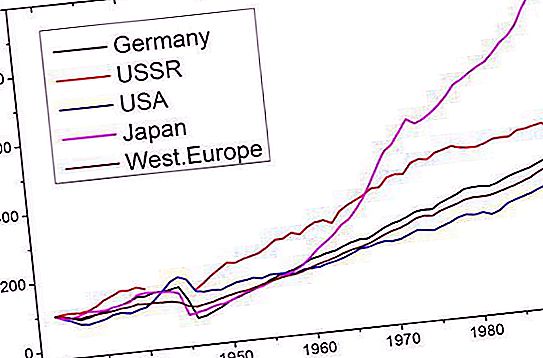
But in subsequent years, an almost continuous decline began, which clearly characterized the state of the USSR economy of that period. The only episode of short-term growth was observed in 1986. The 1990 GDP of the USSR amounted to 778, 400 million dollars. This was the seventh largest result in the world, and the total share of the Soviet Union in world gross product was 3.4%. Thus, when compared with 1970, the gross product increased by $ 345, 000 million, but at the same time, since 1982, it fell by $ 559, 600 million.
But here you need to take into account one more detail, the dollar, like any currency is subject to inflation. Therefore, $ 778, 400 million in 1990 in terms of 1970 prices will be $ 1, 092 million. As you can see, in this case from 1970 to 1990 we will see an increase in GDP of $ 658, 600 million.
We examined this value of nominal GDP, if we talk about GDP at purchasing power parity, then in 1990 it amounted to $ 1971.5 billion.
The value of the gross product for individual republics
Now let's take a look at how much in 1990 the USSR’s GDP amounted to republics, or rather, how much in percentage terms each subject of the Union put into the total piggy bank of gross income.
More than half of the total boiler, naturally, brought the richest and most populated republic - the RSFSR. Its share was 60.33%. Then followed the second most populated and third largest territory republic - Ukraine. The gross domestic product of this subject of the USSR amounted to 17.8% of the total. The third largest republic is Kazakhstan (6.8%).

Other republics had the following indicators:
- Belarus - 2.7%.
- Uzbekistan - 2%.
- Azerbaijan - 1.9%.
- Lithuania - 1.7%.
- Georgia - 1.2%.
- Turkmenistan - 1%.
- Latvia - 1%.
- Estonia - 0.7%.
- Moldova - 0.7%.
- Tajikistan - 0.6%.
- Kyrgyzstan - 0.5%.
- Armenia - 0.4%.
As you can see, the share of Russia in the composition of the all-Union GDP was greater than all other republics combined. At the same time, Ukraine and Kazakhstan also had a rather high share of GDP. Other subjects of the USSR have much less.
Modern gross product of the former Soviet republics
For a more complete picture, take a look at the GDP of the countries of the former USSR today. Let us determine whether the arrangement of the former Soviet republics has changed in terms of gross domestic product.
The size of GDP according to the IMF for 2015:
- Russia - $ 1325 billion
- Kazakhstan - $ 173 billion
- Ukraine - $ 90.5 billion
- Uzbekistan - $ 65.7 billion
- Belarus - $ 54.6 billion
- Azerbaijan - $ 54.0 billion
- Lithuania - $ 41.3 billion
- Turkmenistan - $ 35.7 billion
- Latvia - $ 27.0 billion
- Estonia - $ 22.7 billion
- Georgia - $ 14.0 billion
- Armenia - $ 10.6 billion
- Tajikistan - $ 7.82 billion
- Kyrgyzstan - $ 6.65 billion
- Moldova - $ 6.41 billion
As you can see, Russia remained the undisputed leader in the GDP of the USSR countries. At present, its gross product is $ 1325 billion, which is even greater in nominal value than it was in 1990 as a whole in the Soviet Union. Kazakhstan came in second place, ahead of Ukraine. Uzbekistan and Belarus have also swapped places. Azerbaijan and Lithuania remained in the same places where they were in Soviet times. But Georgia has slid noticeably, letting forward Turkmenistan, Latvia and Estonia. Moldova slid to the last place among the post-Soviet countries. And she missed forward, the last in Soviet times, Armenia's last GDP, as well as Tajikistan and Kyrgyzstan.
US GDP from 1970 to 1990
Now let's take a look at the dynamics of changes in the US gross domestic product over the last period of the existence of the USSR from 1970 to 1990.
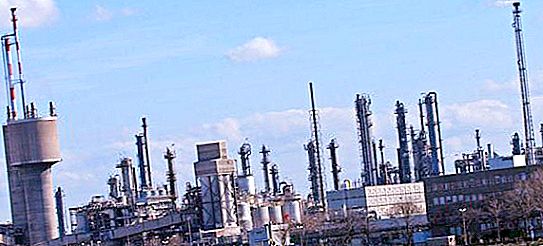
The dynamics of US GDP, million dollars:
- 1970 - 1, 075, 900.
- 1971 - 1, 167, 800.
- 1972 - 1, 282, 400.
- 1973 - 1 428 500.
- 1974 - 1, 548, 800.
- 1975 - 1 688 900.
- 1976 - 1 877 600.
- 1977 - 2, 086, 000.
- 1978 - 2, 356, 600.
- 1979 - 2 632 100.
- 1980 - 2, 862, 500.
- 1981 - 3, 211, 000.
- 1982 - 3 345 000.
- 1983 - 3 638 100.
- 1984 - 4, 040, 700.
- 1985 - 4 346 700.
- 1986 - 4, 590, 200.
- 1987 - 4 870 200.
- 1988 - 5, 252, 600.
- 1989 - 5, 657, 700.
- 1990 - 5, 979, 600.
As you can see, the nominal GDP of the United States, in contrast to the gross domestic product of the USSR, continuously grew from 1970 to 1990. Over 20 years, it increased by $ 4, 903, 700 million.
The current level of the US economy
Since we looked at the current state of the gross product level in post-Soviet countries, we should find out how the United States is doing with this matter. According to the IMF, US GDP in 2015 amounted to $ 17, 947 billion. This is more than three times the 1990 figure.
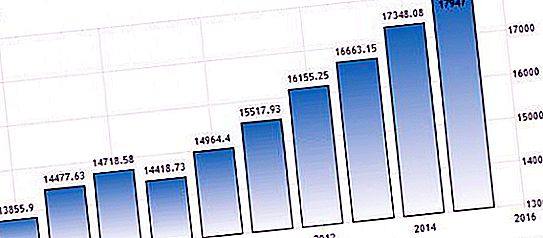
Also, this value is several times larger than the GDP of all post-Soviet countries combined, including Russia.
Comparison of the gross product of the USSR and the USA for the period from 1970 to 1990
If we compare the level of GDP of the USSR and the USA for the period from 1970 to 1990, we will see that if, in the case of the USSR, since 1982, gross product began to decline, then the United States grew continuously.
In 1970, the gross product of the USSR amounted to 40.3% of the same indicator of the United States, and in 1990 - only 13.0%. In real terms, the gap between the GDP of both countries reached $ 5, 201, 200 million.
For reference: Russia's current GDP is only 7.4% of US GDP. That is, in this regard, the situation, in comparison with 1990, has become even worse.




